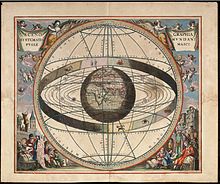Natural science
![]()
Naturwissenschaften is a redirect to this article. For other meanings, see Natural sciences (disambiguation).
The term natural science covers sciences that work empirically and are concerned with the study of nature. Natural scientists observe, measure and analyse the states and behaviour of nature using methods designed to ensure the reproducibility of their results, with the aim of identifying regularities. In addition to explaining natural phenomena, one of the most important tasks of natural science is to make nature useful. The natural sciences thus form part of the theoretical basis of various disciplines such as technology, psychology, medicine or environmental protection.
In the 17th century, the natural sciences made a decisive breakthrough in the intellectual strata of society. This triggered a scientific revolution in connection with enlightenment, which led to the industrial age in the 18th century with many new discoveries and inventions and changed society greatly, especially in the western world. To this day, it is so strongly shaped by the general scientific enterprise that sociology speaks of a scientific and technical society.
Subfields of the natural sciences include astronomy, physics, chemistry, biology, as well as some environmental sciences such as geology, but also agricultural sciences. The technical usability of natural laws has always been dealt with in various engineering sciences.
Classification and delimitation
According to a classical view, the natural sciences can be classified alongside the humanities and the social sciences. Due to the emergence of a variety of new branches of science in modern times, there is no consensus on a general classification of the individual sciences. The classification proves to be difficult, especially because of many overlaps between different fields of science. The natural sciences belong to the empirical sciences. They are characterized primarily by their object of research, the animate and inanimate matter. Some natural sciences are characterized by a mathematical approach to their object of research. These are called exact sciences. Mathematics is also an exact science, but with its study of abstract structures it encompasses areas of both the humanities and the natural sciences. For this reason, it is often assigned to the structural sciences alongside computer science.
Scientific research is primarily concerned with questions that can be answered by investigating lawful relationships in nature. The focus is on the description of the process itself and not on finding meaning. Simplified it can be represented with the question of how instead of why. The question "Why does it rain?" is not explained by "So that plants can grow", but is answered objectively: Because water evaporates, rises, collects in clouds, and finally condenses, resulting in precipitation. Natural science, therefore, does not primarily answer teleological questions (oriented towards purpose or goal), but rather traces the processes under investigation back to natural laws or to already known facts. Insofar as this succeeds, natural science is not only attributed a descriptive but also an explanatory character.
History of Natural Science
→ Main article: History of the natural sciences
Natural philosophy of the ancient world
Natural scientific knowledge began on the one hand in manual and technical activity and on the other hand in the spiritual tradition of man's learned tradition. Observations of nature in ancient cultures - especially in astronomy - often produced accurate quantitative and qualitative statements, but were mainly interpreted mythologically, as in astrology. Decisive progress was made by Greek natural philosophy with the development of a methodology that was oriented towards philosophy and mathematics. The perceptible world was thought of as a composition of the "elements" fire, air, water and earth, as in the four-element theory, and various transformation processes were described. Also the idea of smallest, indivisible particles (atomism), of which the whole world is composed, was developed. The periodic movements of the celestial bodies, already known for a long time, were interpreted geometrically and the idea of a world system was developed in which the sun, the moon and the planets known at that time moved on circular paths around the resting earth in the middle (geocentric world view). The spherical shape of the earth was assumed and substantiated by Aristotle at the latest, the occurrence of solar and lunar eclipses was explained, relative distances of the earth, sun and moon were estimated and even the circumference of the earth was determined quite accurately by measuring angles and geometric considerations.
In the Roman Empire, the intellectual achievements of Greek culture were for the most part adopted and further developed, with a heyday in the imperial period, but were for the most part lost with the disintegration of the empire in the 5th century AD. In medieval Europe, under the primacy of theology and philosophy in both the Christian and Islamic worlds, the natural sciences could develop only slowly and within the framework of ideological premises.
Copernican turn and scientific revolution
It was not until the Renaissance that a greater interest in the observation of nature re-emerged. Through the rapprochement of science to the craft tradition in the empirical method, new knowledge was gained in all fields. The interaction of alchemy and medicine enriched both disciplines as they developed into empirical sciences. The correction of the old Julian calendar and navigation in ocean-wide shipping required an intensive study of astronomy. Nicolaus Copernicus, starting from a motion of the earth around the sun, developed a world system that explained the celestial orbits of the planets, which appeared complicated from the earth, in simpler terms and, compared with the Ptolemaic system, allowed easier, though not more accurate, calculation of positions. Francis Bacon and Galileo Galilei demanded that natural research should be based on experiment, with Galilei being particularly successful in promoting the mathematical evaluation of numerical measurement results. However, the Copernican world system only began to prevail over the geocentric world view after Johannes Kepler had established elliptical orbits of the Earth and the other planets from precise measurements by Tycho Brahe, Galileo Galilei had observed the moons of Jupiter and the phases of the planet Venus, and Isaac Newton was able to confirm all this theoretically through his law of gravitation within the framework of the mechanics he had developed. The term Copernican turn was coined for these revolutionary discoveries of the 16th and 17th centuries. Historians of science also regard this scientific revolution as the forerunner of modern natural science.
Modern science
Experts do not agree on a precise definition and the temporal beginning of modern natural science. Often, in overlap with the scientific revolution, the 17th century is given as the time frame for the beginning of modern natural science. Important features are considered to be the professionalization of science, the development and application of scientific methodology, and later the formation of disciplines through specialization.
The establishment of scientific societies, academies and new universities marked the beginning of an independent scientific tradition in Europe. In France, scholars - influenced by Descartes' rationalist philosophy - devoted themselves to the theoretical description of natural phenomena with an emphasis on the deductive method. In England, on the other hand, due to Bacon's influence, interest was directed towards the empirical method, which is why experimentation was increasingly used to meet technical challenges. This is also seen as one of the reasons why the Industrial Revolution began in England in the second half of the 18th century. Numerous groundbreaking discoveries and inventions ushered in an unmistakable social and economic change that spread to mainland Europe and America in the following decades.
With the strong increase in knowledge since the 18th century, a basic understanding of the structure of the empirically accessible world could gradually be developed, which made it possible to divide the natural sciences into disciplines such as biology, chemistry, geology and physics. Although differences developed in the methodology of the disciplines, they influenced and complemented each other. For example, the metabolic processes studied in biology could be explained and studied in more detail by organic chemistry. Furthermore, modern atomic theories in physics provided explanations of the structure of atoms and thus contributed to a better understanding of the properties of elements and chemical bonds in chemistry. In addition, disciplines such as medicine, agriculture and engineering developed applications for theoretical knowledge.
In the first half of the 20th century, physics experienced a remarkable upheaval that was to have serious consequences for the self-understanding of natural science. With the foundation of quantum physics, Max Planck and Albert Einstein established that energy - especially in light waves - only occurs in discrete quantities, i.e. is quantized. Furthermore, Einstein developed the special theory of relativity (1905) and the general theory of relativity (1915), which led to a new understanding of space, time, gravity, energy and matter. Another upheaval was marked by quantum mechanics, founded in the 1920s and 30s, which showed striking differences from the classical conception of atoms in its description of objects at the atomic level. There, it was discovered that certain properties of particles cannot be measured simultaneously with arbitrary precision (Heisenberg's uncertainty principle) and that, for example, electrons of an atom cannot be precisely localized but can only be described in terms of certain probabilities about their whereabouts. These discoveries are largely beyond human comprehension, but they unfold their great significance in their mathematical formulation and are of great importance for numerous applications of modern technology.
During the Second World War and the Cold War, scientific research - especially nuclear technology - was strongly promoted because it was a prerequisite for the technical and military superiority of the great powers. Since then, the term "large-scale research" has become established for the massive expansion of research facilities.

Representation of the Ptolemaic world view by Andreas Cellarius (1660)

Nicolaus Copernicus. Copper engraving from 1597 by Robert Boissard. The Latin inscription means: "Copernicus does not teach that the orbits of the heavens are discontinuous, but rather that the orbit of the earth is discontinuous.
Questions and Answers
Q: What are natural sciences?
A: Natural sciences are sciences used to study nature and the rules that govern it.
Q: What is the scientific method?
A: The scientific method is a process used in natural sciences to discover unknown rules and make observations.
Q: What does physics study?
A: Physics studies how nature is made and how different fields of nature relate to each other.
Q: What is chemistry about?
A: Chemistry is about the elements, their combinations, and their reactions.
Q: What does biology study?
A: Biology studies living organisms, their development, and how they interact with each other.
Q: What does geology look at?
A: Geology looks at how the earth developed and what it looks like.
Q: What are social sciences?
A: Social sciences are sciences that mainly study human behavior, society, and how humans think and behave.
Search within the encyclopedia